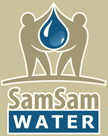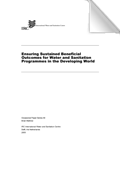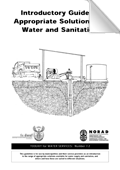
Filter op categorie
Of zoek
Zoekformulier wordt geladen...
Toelichting
SamSamWater maakt informatie over water en sanitatie beschikbaar en toegankelijk voor iedereen.
Hierom hebben we een database opgezet, die via deze pagina geraadpleegd kan worden. De database bevat allerlei informatie, bijvoorbeeld 'best practices' (bewezen technieken), kaarten, geo-informatie en achtergrondinformatie. De informatie is afkomstig van verschillende bronnen, waaronder onderzoeksinstituten, bedrijven, organisaties en overheidsinstellingen.
Als u informatie heeft die wij in onze database kunnen opnemen, of als u opmerkingen of vragen heeft, dan horen wij dit graag!
N.B. De documenten en beschrijvingen op deze pagina zijn vooralsnog alleen beschikbaar in het Engels. Als u behoefte heeft aan een Nederlandse vertaling dan kunt u rechtsboven op deze pagina op "Overige talen" klikken. Vervolgens kunt u "Nederlands" selecteren in het pull down menu, waarna deze pagina via een automatische vertaling naar het Nederlands vertaald zal worden.
8 items gevonden in de categorieën:
Sanitatie
Verwijder zoekfilter.
Brian Mathew, IRC (2005)
WHO, WHO (2006)
Richard Holden, Tania Swanepoel, DWAF (2004)
NWP, NWP (2006)
WaterAid, WaterAid (2007)
Sanitatie
Verwijder zoekfilter.
SSWM Toolbox
The Sustainable Sanitation and Water Management Toolbox is an open-source capacity development tool for the local level, linking water management, sanitation and agriculture.
Focussing on the human influence on the water and nutrient cycle, it presents solutions for a sustainable use, treatment and reuse of water resources.
The Toolbox aims at capacitating people not only with knowledge, but also with application skills. It provides both help in project planning and implementation, focuses on technologies (hardware) and behavioural change approaches (software), and compiles the relevant further readings, links, exercises etc. for each topic. In that way, it is not a reinvention of the wheel, but the long needed overview on the host of approaches and technologies in the water and sanitation sector. The Toolbox contains also a large library, a glossary, a Train-the-Trainer's section topped by downloadable and adjustable PowerPoint presentations on specific topics. It is open source and for free – but quality approved. Today, the Toolbox is used as online resource for both, learning and teaching. This concept is coupled with training courses and workshops based on a worldwide network.
Focussing on the human influence on the water and nutrient cycle, it presents solutions for a sustainable use, treatment and reuse of water resources.
The Toolbox aims at capacitating people not only with knowledge, but also with application skills. It provides both help in project planning and implementation, focuses on technologies (hardware) and behavioural change approaches (software), and compiles the relevant further readings, links, exercises etc. for each topic. In that way, it is not a reinvention of the wheel, but the long needed overview on the host of approaches and technologies in the water and sanitation sector. The Toolbox contains also a large library, a glossary, a Train-the-Trainer's section topped by downloadable and adjustable PowerPoint presentations on specific topics. It is open source and for free – but quality approved. Today, the Toolbox is used as online resource for both, learning and teaching. This concept is coupled with training courses and workshops based on a worldwide network.
Akvopedia from Akvo.org
Wikipedia-like knowledgebase on water and sanitation. Contains many useful smart and affordable technical solutions and effective approaches.
Appropedia
Wikipedia-like knowledgebase on collaborative solutions in sustainability, poverty reduction and international development. Including sections on Water and Health.
Ensuring Sustained Beneficial Outcomes for Water and Sanitation Programmes in the Developing World
Brian Mathew, IRC (2005)
A thesis that gives approaches to achieve sustained beneficial outcomes from WATSAN (WAter and SAnitation projects in development countries). Secondly it gives insight in the up-scaling of these approaches, (source)
Serie:
Occasional Paper Series 40 (alle items in deze serie)
Categorieën:
Socio-economisch en organisatorisch
Sanitatie
Occasional Paper Series 40 (alle items in deze serie)
Categorieën:
Socio-economisch en organisatorisch
Sanitatie
Guidelines for drinking-water quality
WHO, WHO (2006)
The document describes a “Framework for Drinking-water Safety” and discusses the roles and responsibilities of different stakeholders, including the complementary roles of national regulators, suppliers, communities and independent “surveillance” agencies.
Introductory Guide to Appropriate Solutions for Water and Sanitation
Richard Holden, Tania Swanepoel, DWAF (2004)
This guideline is for use by municipalities and their service providers as an introduction to the range of appropriate solutions available for water supply and sanitation, and where and how these are suited to different situations. (source)
Smart Sanitation Solutions
NWP, NWP (2006)
This booklet on sanitation, like its counterpart Smart Water Solutions, gives examples of household and community-based sanitation solutions that have proven effective and affordable. It illustrates a range of innovative sanitation technologies that have already helped thousands of poor families to improve their lives. The technologies described are a source of inspiration. (source)
Technology notes
WaterAid, WaterAid (2007)
These technology notes have been prepared following many general enquiries for technical information having been received by WaterAid over the years.
Their purpose is to give an outline of the technologies used by WaterAid on long-term development projects in Africa and Asia, and to show alternatives which might be appropriate in different circumstances.
It may be possible to determine from the notes the technology which would be appropriate in a particular location.
If it is proposed to proceed with the design and construction of a project using any of the principles set out in these notes, it is strongly recommended that further details be obtained from a specialist or from the reference books which are listed at the end of the relevant section. (source)










